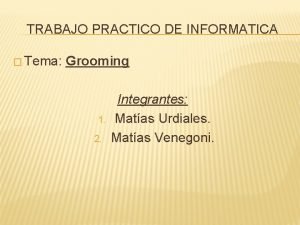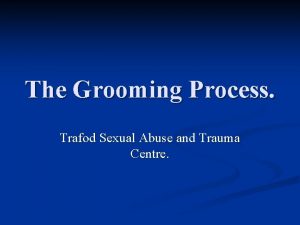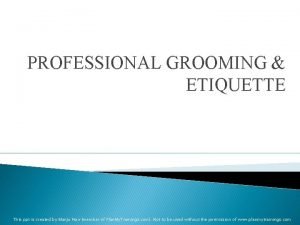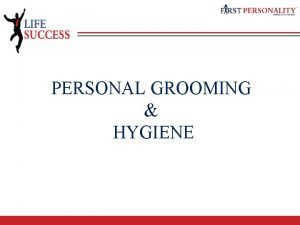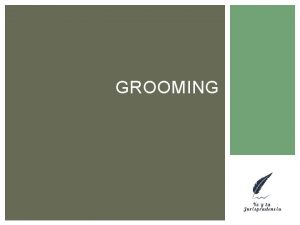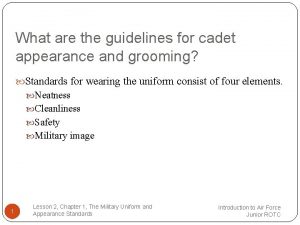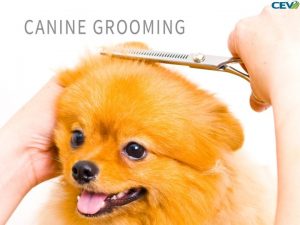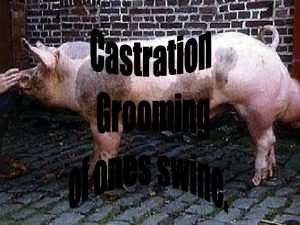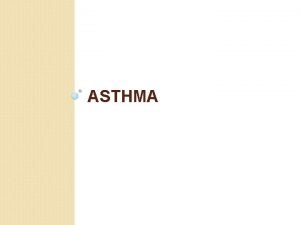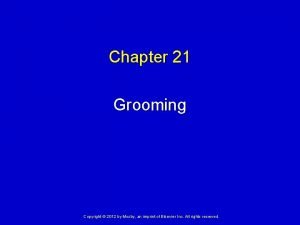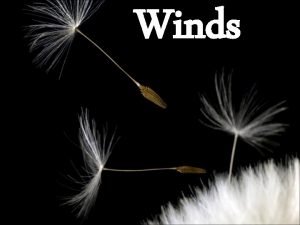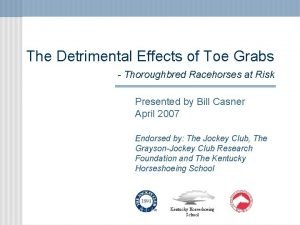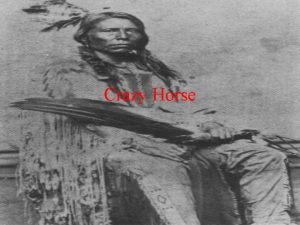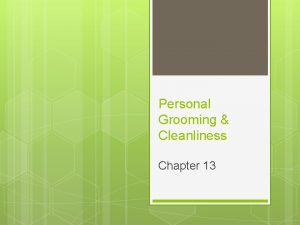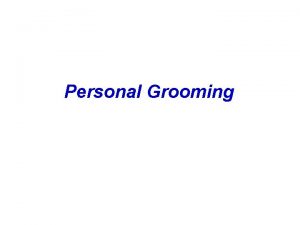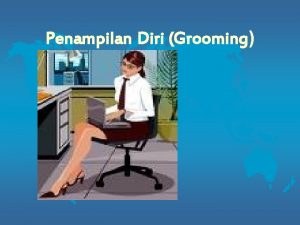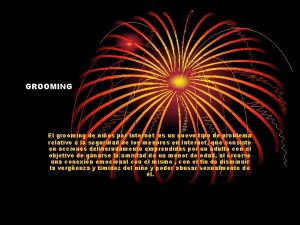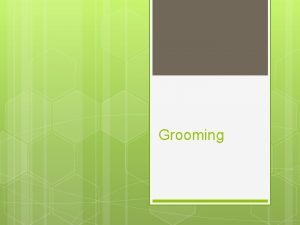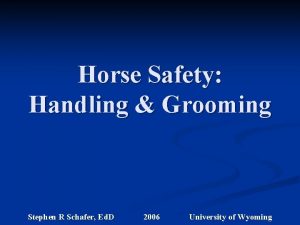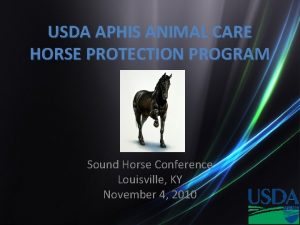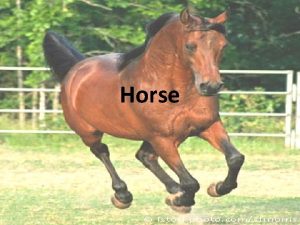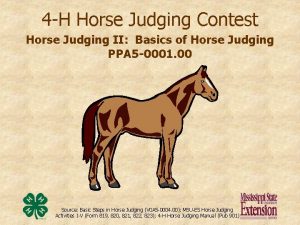Care of animal Grooming of horse Horse grooming



























































- Slides: 59

Care of animal

Grooming of horse • Horse grooming is hygienic care given to a horse, or a process by which the horse's physical appearance is enhanced for horse shows or other types of competition.

Types of grooming 1 - Mutual Grooming: approaches another and starts to nibble at coat usually at the withers two horses stand nose to tail and nibble each others’ backs. If one horse stops grooming, then the other one does too.

2 - Self- Grooming: . scratch their own bodies hooves, teeth and lips. . Rolling Roll the body in soft sands earth

Tools used for grooming

Steps of grooming 1 -Pick your horse's hooves

• Using a hoof pick, start at the heel of the foot and pick forward to the toe, carefully removing all rocks, dirt and other foreign objects. The frog (the V-shaped squishy part of the hoof) is extremely sensitive, so be careful about hitting it

2 - Use a curry comb to remove loose hair from the horse

• Rubber curry combs are built to loosen up dirt, mud, and bits of things caught in your horse's coat which generally you follow the direction of the way that the fur goes • Use the curry in vigorous, small circular motions over the horse's muscles, avoiding bony areas like the face, spine and legs • On one side, work your way from the neck, to the barrel, and all the way to the rump. Then, repeat on the other side of the horse. • The curry comb should be rubbed in a circular motion in the direction opposite of the hair growth. This will pull up loose hairs and dirt that otherwise would just be brushed over.

3 -Use a dandy brush (the hard brush)

• A dandy brush (or hard brush) is a hard-bristled brush used to take off the dirt and hair brought out by the curry comb. • Use the brush in short straight flicking motions to allow the bristles to get all the way through the coat and whisk the dirt out • Start at the neck and work towards the tail. Run the brush down the horse's legs to remove built up dirt but don't be too afraid to brush but not too hard that it would hurt the horse • Do not use on the face, ears, belly, mane, tail, or any clipped area, as this can cause the horse to be in immediate discomfort

4 - Clean up with a soft brush

• can be used on all areas of the horse as a result of its texture. The soft brush removes any remaining surface dust, and hair. Finish up your body-grooming by brushing down the entire body, including on sensitive areas like the face and belly.

5 - Clean the horse's face

• Take a wet sponge and wipe your horse's eyes and clean out his nose. Use a different sponge/cloth/wipe for the dock area (under the tail). Because these areas are constantly moist, dirt and mucus build up and need to be cleaned out. • Use different sponges/cloths for each horse (if you are grooming multiple) to avoid spreading infection.

6 - Brush out the mane and tail

• Use a wide- bristled mane comb or brush to get tangles out of the mane and tail. Before you start, use your fingers to separate the hairs caught in large tangles • Hold the whole tail/large section of mane in one hand (to avoid tugging) and brush it out with the other • Make sure you stand to the side of the horse when grooming the tail or backside of the horse. And make sure to talk to the horse and keep your hand on the horse so that it does not get spooked

• If you want to use hair product, use natural mane/tail sprays that are all natural it will moisturize and make the hair look shiny

Dressings and polish the hoof • Hoof dressing is a liquid substance used on the hooves to improve their moisture content, which in turn helps prevent hoof cracks

The Benefits of Grooming Your Horse 1. Grooming gets your hands on your horse. during this daily routine you have an opportunity to get your hands on every inch of your horse

2. Grooming acts as preventive medicine • A good grooming session increases blood flow to the skin’s surface, massages large muscle groups, and daily hoof picking keeps the feet clean and helps prevent common hoof issues such as thrush, a bacterial disease of the sole.

3 - Grooming increases the humananimal bond. 4 - It improves your horse's health 5 - Improves your horse's appearance 6 - reduces the risk of skin diseases and parasites, and prevents rubs and sores from forming.

Bedding of farm animals

Importance 1 - comfort 2 - warmth 3 -protection legs of animals and prevent abrasions 4 -cleanliness 5 - sick animals------ encourage recumbence and rest by extra bedding.

Ideal bedding 1 - provide a level elastic surface 2 - Dry and warm 3 - absorb and deodorize all urine 4 -have no injurious action on hoofs 5 -Straws should be long , dry , clean , free from moulds and bright incolour

Examination of the beddings straw 1 - Stems should not be much crushed 2 - Mouldness detected by smell and discolored spots 3 - Dampness detected by feel

Bedding materials for horses 1 - wheat straw: • Best forstall or loose box • Straws must be Yellow , clean, long, unbroken • Straws used Wheat, barely, rice,

• 2 - saw dust • 3 -wood shavings • 4 - sand: - Un suitable for horses eat bed

Bedding of cattle • 1 - wheat straw • 2 - oats straw • 3 - saw dust

Management of bedding • 1 - must kept clean, dung and soiled bedding must be removed every morning • 2 -clean portion must be dried in the sun and aereated • 3 - it is undesirable to leave bedding in the stall the day , since it undergoes decomposition.

• 4 - Floor should be swept down once a day, the should housed with water once a week and disinfected • 5 - Bedding should be laid at night just before or just after horses return in evening • 6 - Arrange bedding in layers longitudinally and transversally.

sheep dipping

in sheep dip

• Sheep dip is a liquid formulation of insecticide and fungicide which shepherds and farmers may use to protect their sheep from infestation against external parasites

Purpose • To eradicate ectoparasites • cure and prevent spread of sheep scab (mange) • remove waste material and dung from the fleece prior to shearing, thus facilitating production of clean wool.

Time of dipping • sheep can be dipped immediately after the shearing. • they can be dipped 1 -4 weeks after shearing, when the fleece has grown long enough to retain dip solution and also allow cuts and scratches incidental to shearing time to heal.

Dipping chemicals used Lindane (0. 25%), DDT (0. 5%), Garathion, Malathion (2. 0%), Cimathion, Pyrethrin-arsenic sulphide powder (0. 2% arsenic), • Butox (Highly effective and safe ectoparasiticide only for external use. Ideally suited for control of ticks, mites, Lice and flies of livestock) • •

Dipping tanks : 1 -Hand bath : In case of small flocks, a tank of galvanized iron can be used. Sheep can be lifted one by one into the bath and kept for two minutes.


2 -Swim bath : In large flocks, the dipping tank can be constructed of metal or concrete. The sheep should be completely immersed in the liquid (including their heads and ears).


Sheep Dipping

Precautions – Follow the manufacturer's instructions thoroughly for preparation of the dip as well as its disposal. – Always water and rest the sheep before dipping to avoid their drinking of dipping solution. – Choose a bright, sunny day (neither too hot nor too cold) so that the treated animals will dry quickly and the insecticide will not be diluted by rain. – Avoid dipping of sheep in advanced stage of pregnancy. – Avoid dipping of sick animals, sheep with wounds, young lambs (less than one month old) and stock being sent for slaughter.

– Avoid dipping of rams in breeding season to avoid injury to penis or scalding of thigh. – Keep sheep in the holding pen for at least five to ten minutes so that they drain properly, thus avoiding wastage of dip and resultant pollution of the environment. – Complete each day's dipping by 4 PM so that the sheep will have some hours to dry before nightfall

After dipping • Always allow sheep to drain thoroughly in the draining pen. Never allow freshly dipped sheep to contaminate watercourses. This may happen if sheep have access to streams or rivers immediately post dipping • wash your hands and any exposed skin, eg your face and neck, with soap and clean running water; • do not allow rinsing or washing water to contaminate groundwater or watercourses;

• do not work among or handle recently dipped sheep • wash your hands and any exposed skin after handling recently dipped sheep; • return any unused dip concentrate to a suitable storage facility ,

Sheep shearing

• Sheep shearing is the process by which the fleece of a sheep is cut off • The person who removes the sheep's wool is called a shearer • Typically each adult sheep is shorn once each year

Types of shearing 1 - Hand shears 2 - with electric shears or shearing machines.

When to Shear • Sheep are shorn in all seasons, depending on the climate, management requirements • in the spring before the onset of warm weather • Sheep with long fleeces are sometimes sheared twice a year. • Feeder lambs are sometimes sheared to make them more comfortable during the summer.

• Shearing before lambing helps to keep the animals cleaner during birthing as they won't have a full fleece for blood and afterbirth to collect in. Some shepherds also believe the lambs have an easier time finding the udder on a shorn ewe. • Producers who lamb in the winter may opt to crutch rather than do a full removal of the entire body fleece.

Preparation before the shearing Do not shear wet sheep. Hold off feed and water for at least 4 h. cleaner shearing floor. The shearing area should be swept after each sheep to provide a clean surface for the next. • •

Shearing devices – Blade shears – Machine shears Comb Hand/blade shears Electric shears Cutter

New technologies • Because sheep shearing is so labor-intensive, other technologies are often being explored for more efficient wool removal. Australian scientists created a chemical method of shearing called "bio-clip. " With bio-clip, the sheep are injected with a natural protein that causes the wool follicle to break and the fleece to drop off on its own.

Advantages of Bioclip™ over conventional shearing include: • elimination of second-cuts and skin pieces • reduced the need for chemicals used to control parasites • reduced variability in wool fibre length


Freshly shorn sheep • Freshly shorn sheep need protection from the elements. It takes up to six weeks for the fleece to re-grow sufficiently to provide effective insulation. • Sheared sheep also require more feed to maintain their body temperatures, especially during the winter.

Unhygienic shearing • During hand shearing by scissors , sheep may be injured so the Corynebacterium organism may enter and cause casseous lymphadenitis (pseudo- tuberculosis of sheep)

 Primary, secondary, tertiary care
Primary, secondary, tertiary care Horse gives us
Horse gives us Equs caballus
Equs caballus Venn diagram of plant and animal cell
Venn diagram of plant and animal cell Animal cell venn diagram
Animal cell venn diagram Animal rights vs animal welfare
Animal rights vs animal welfare Columbus animal care and control
Columbus animal care and control Irvine animal shelter volunteer
Irvine animal shelter volunteer Care certificate standard 3
Care certificate standard 3 Este fenomenul prin care corpurile care contin fier
Este fenomenul prin care corpurile care contin fier Palliative care versus hospice care
Palliative care versus hospice care Inmultirea animalelor
Inmultirea animalelor Care sunt simturile prin care sunt evocate
Care sunt simturile prin care sunt evocate Standard 1 care certificate answers
Standard 1 care certificate answers Hip fracture care clinical care standard
Hip fracture care clinical care standard Health and social care unit 2
Health and social care unit 2 Grooming definition
Grooming definition Trabajo práctico sobre grooming
Trabajo práctico sobre grooming What is self grooming
What is self grooming Corporate grooming ppt
Corporate grooming ppt Importance of personal hygiene.
Importance of personal hygiene. Grooming berasal dari kata groom yang berasal dari bahasa
Grooming berasal dari kata groom yang berasal dari bahasa What is grooming
What is grooming Infested
Infested Origen del grooming
Origen del grooming Grooming and body language
Grooming and body language Grooming for interview
Grooming for interview Christian grooming and manners honor answers
Christian grooming and manners honor answers Grooming rituals examples
Grooming rituals examples User stories grooming
User stories grooming Specific female cadet guidelines
Specific female cadet guidelines Navy earrings regulation
Navy earrings regulation Soft skills grooming
Soft skills grooming Personal hygiene and grooming
Personal hygiene and grooming Jrotc cadet appearance and grooming standards
Jrotc cadet appearance and grooming standards Grooming objectives
Grooming objectives Employee grooming
Employee grooming Chapter 23 grooming
Chapter 23 grooming Grooming objectives
Grooming objectives The parent guide with
The parent guide with Personal grooming definition
Personal grooming definition Personal grooming presentation
Personal grooming presentation Qué significa grooming
Qué significa grooming Grooming je
Grooming je Chapter 23 grooming
Chapter 23 grooming Net yield of glycolysis
Net yield of glycolysis Why are they called horse latitudes
Why are they called horse latitudes Horse latitude
Horse latitude Trojan horse letter pdf
Trojan horse letter pdf War horse characters
War horse characters Horse latitude
Horse latitude Horse latitudes
Horse latitudes Hob nailed wake
Hob nailed wake Toe grabs
Toe grabs Stone age horse
Stone age horse Donkey mule and horse
Donkey mule and horse The white horse or the productivists
The white horse or the productivists Phenotype
Phenotype Setting of jake story
Setting of jake story Immediacy principle linguistics
Immediacy principle linguistics

















